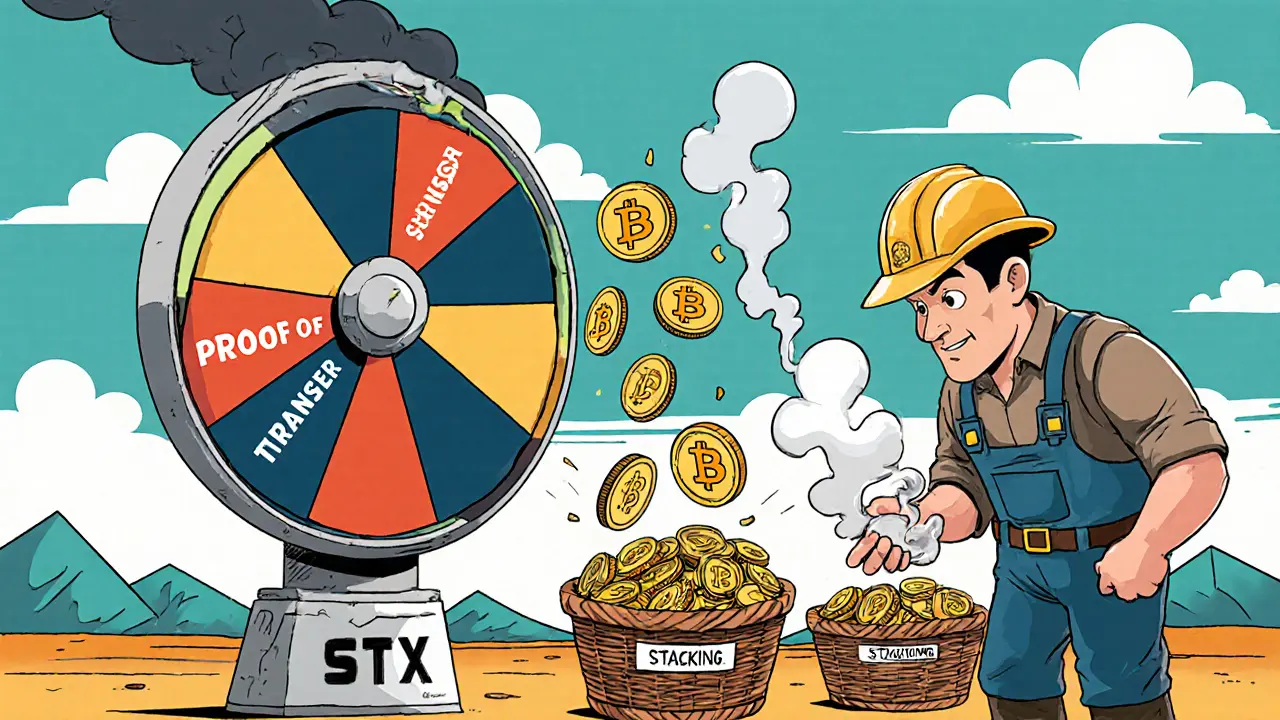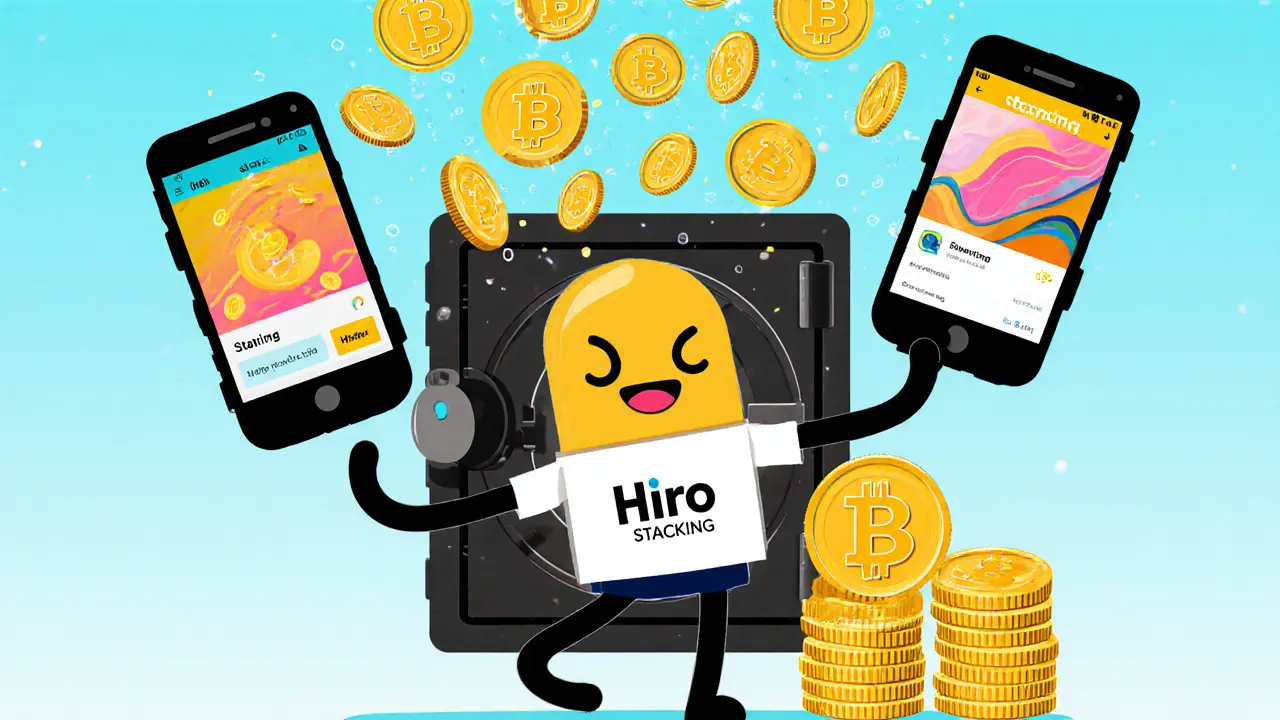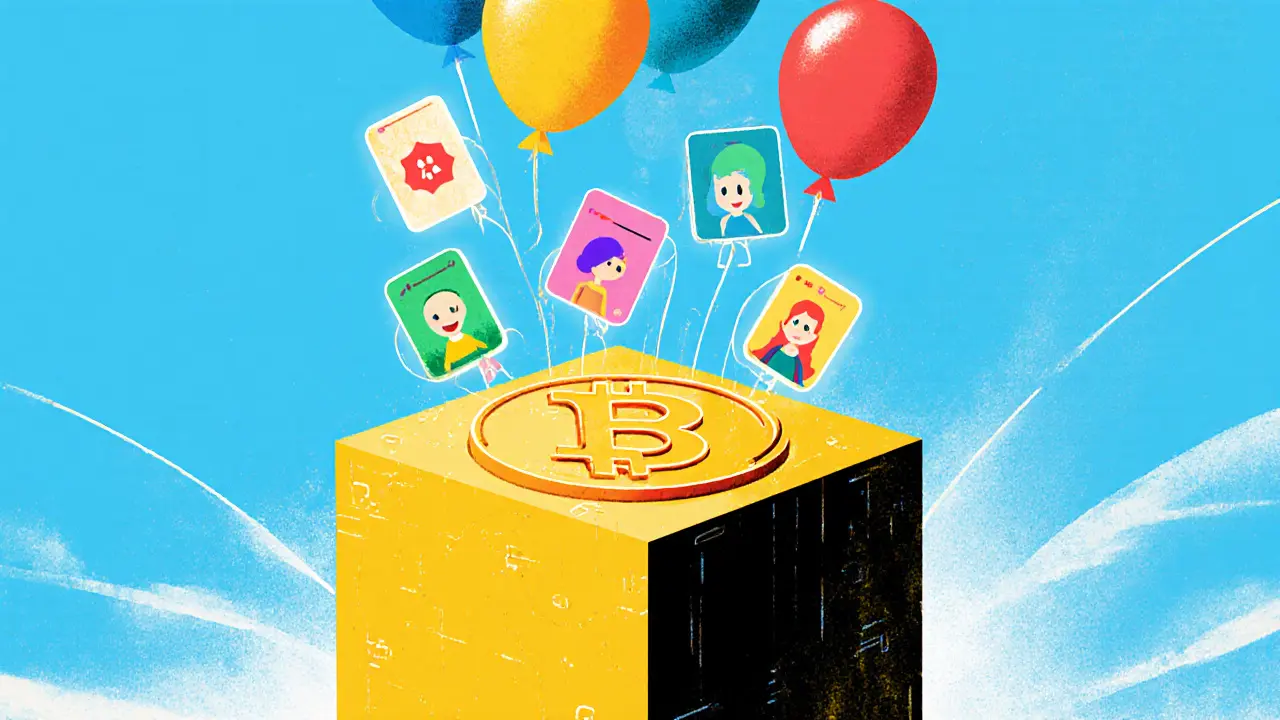Stacking Reward Calculator
Calculate your potential Bitcoin rewards from stacking STX tokens. This tool estimates rewards based on current network conditions and historical averages. Note: Actual rewards vary based on network activity and staking participation.
Estimated Rewards
Enter your values above to see estimated rewards
Important Note: Stacking is not staking. You earn Bitcoin (BTC) by locking STX tokens. Your STX remains safe with no slashing risk. Rewards are distributed automatically after each reward cycle (typically every 2 weeks).
Most people know Bitcoin as digital gold - secure, slow, and simple. But what if you could use Bitcoin to run apps, trade NFTs, or earn more Bitcoin just by holding your coins? That’s where Stacks (STX) comes in. It’s not a rival to Bitcoin. It’s an add-on. A layer built right on top of it, without changing a single line of Bitcoin’s code.
What Exactly Is Stacks (STX)?
Stacks (STX) is a cryptocurrency designed to bring smart contracts and decentralized apps to Bitcoin. Think of it like adding apps to your phone without replacing the operating system. Bitcoin handles security and settlement. Stacks handles the logic - like lending, trading, or gaming - all while staying anchored to Bitcoin’s unbreakable network.
It wasn’t always called Stacks. Back in 2017, it started as Blockstack, founded by two Princeton grads who were tired of tech giants controlling user data. Their motto? "Can’t be evil." They even put it on a billboard near Google’s HQ. In 2020, they rebranded to Stacks to separate the open-source project from their company, Hiro Systems. The name stuck because it better described what the network does: stacking Bitcoin’s power on top of itself.
How Does STX Work With Bitcoin?
Stacks doesn’t fork Bitcoin. It doesn’t compete with it. It uses Bitcoin’s proof-of-work as its security blanket. That’s done through something called Proof of Transfer (PoX). Here’s how it works:
- Bitcoin miners send BTC to people who lock up STX tokens (called stackers).
- In return, those miners get a chance to win newly minted STX tokens.
- The more BTC they send, the higher their odds.
This turns Bitcoin miners into Stacks validators. They’re not mining STX blocks directly - they’re using Bitcoin’s energy to secure Stacks. It’s like renting out your car’s engine to power a different vehicle. You still own the car, but now it’s helping someone else move.
And here’s the kicker: the BTC that miners send doesn’t disappear. It gets distributed to STX holders as rewards. So if you hold STX and lock it up, you earn Bitcoin. Not more STX. Actual BTC. No slashing. No risk of losing your tokens. Just passive income in the most trusted crypto in the world.
Stacking: The Unique Way to Earn Bitcoin
"Stacking" is the heart of Stacks. It’s not staking. Staking means locking your token to earn more of that same token. Stacking means locking STX to earn Bitcoin.
Every two weeks, the network runs a reward cycle. Miners who sent BTC to stackers during that period get paid in STX. Those STX rewards are then sent back to the stackers - but as BTC. The amount you earn depends on how much STX you locked and how many others are stacking. It’s a fair, decentralized system where Bitcoin holders indirectly fund the network’s growth.
As of 2025, stacking has paid out over 12,000 BTC to STX holders since launch. That’s more than $700 million in Bitcoin rewards, all flowing directly to people who just held their STX. No exchange. No app. No risk.
What Can You Do With Stacks?
Stacks turns Bitcoin into a platform. Here’s what’s already live:
- sBTC - A tokenized version of Bitcoin that works inside Stacks apps. You can use it to trade, lend, or earn yield without moving your BTC off the main chain.
- Bitcoin NFTs - Digital art, collectibles, and game items that are secured by Bitcoin. No Ethereum needed.
- DeFi apps - Lending, borrowing, and swapping tokens using Bitcoin as collateral.
- Web3 identities - Own your username, profile, and data without relying on Google or Apple.
One popular app, Stacks Wallet, lets you stack, swap, and manage your STX and sBTC in one place. Others, like Zest and Hiro Wallet, offer similar tools. All of them connect directly to Bitcoin.

The Nakamoto Upgrade: Faster, Cheaper, More Bitcoin-Friendly
In August 2024, Stacks launched its biggest upgrade yet: Nakamoto. Before this, Stacks had to wait for Bitcoin blocks to confirm transactions - which slowed things down. Nakamoto changed that.
- Stacks now produces its own blocks every 10 minutes - same as Bitcoin - but with instant finality.
- Transaction fees dropped by over 80%.
- Miner extractable value (MEV) - a loophole where miners profit from transaction order - was nearly eliminated.
This made Stacks faster, cheaper, and more secure. It also strengthened Bitcoin’s role: now, every Stacks block is anchored to Bitcoin, making it as immutable as Bitcoin itself.
STX Supply: No Cap, But No Inflation Either
Unlike Bitcoin’s fixed 21 million supply, STX has no hard cap. But that doesn’t mean it’s inflationary.
Every time you pay a fee to deploy a smart contract or execute one on Stacks, the STX you pay is burned - permanently removed from circulation. This offsets new emissions. In fact, since 2021, more than 150 million STX have been burned.
Changes to how many new STX are created? Those require a community vote through a Stacks Improvement Proposal (SIP). It’s a slow, careful process. No one can just print more tokens. The network is designed to be self-correcting.
Why Does STX Matter?
Bitcoin has $1 trillion in value locked in it. But for years, that money sat idle. You couldn’t lend it. You couldn’t trade it. You couldn’t use it in apps.
Stacks unlocks all of that. It turns Bitcoin from a store of value into a programmable asset - without touching its core. No central bank. No trusted third party. Just code, Bitcoin, and community.
It’s also the first crypto to be legally sold in the U.S. under SEC regulation. That’s not just a headline - it means the project has met strict financial disclosure rules. It’s not a gamble. It’s a regulated network.

Where to Get STX and How to Stack
You can buy STX on major exchanges like Coinbase, Kraken, and Binance. Once you have it, you can store it in any wallet that supports the Stacks blockchain - including Hiro Wallet, Xverse, or even Ledger hardware wallets.
To start stacking:
- Buy STX and send it to your Stacks-compatible wallet.
- Lock your STX for a reward cycle (usually 2 weeks).
- Wait. At the end of the cycle, you’ll receive BTC rewards automatically.
You don’t need to run a node. You don’t need technical skills. Just hold, lock, and earn Bitcoin.
Is Stacks Safe?
Yes - because it’s built on Bitcoin. Even if the Stacks network had a bug, your Bitcoin is still safe. All transactions are anchored to Bitcoin’s blockchain. There’s no single point of failure. No centralized server. No CEO who can shut it down.
And because STX is burned with every transaction, the token’s scarcity increases over time. That’s the opposite of most crypto projects that just print more tokens.
What’s Next for Stacks?
The team is working on deeper Bitcoin integration - like direct Bitcoin-based lending and multi-signature wallets that require Bitcoin signatures. They’re also exploring ways to let Bitcoin holders participate in Stacks governance without buying STX.
One thing’s clear: Stacks isn’t trying to replace Bitcoin. It’s trying to make Bitcoin more useful. And that’s a mission worth paying attention to.
Is STX a Bitcoin token?
Yes, but not in the way you might think. STX isn’t a wrapped Bitcoin. It’s a separate cryptocurrency that uses Bitcoin’s security to run smart contracts. You can earn Bitcoin by holding STX, and you can use Bitcoin as collateral in Stacks apps - but STX itself is its own token with its own rules.
Can I mine STX with my GPU?
No. You can’t mine STX like you mine Bitcoin. Instead, you stack STX to earn Bitcoin. If you want to earn STX, you need to send Bitcoin to the network as a miner. That requires specialized software and BTC - not a GPU.
Is stacking the same as staking?
No. Staking locks your token to earn more of that same token. Stacking locks STX to earn Bitcoin. There’s no slashing risk. You don’t lose your STX. You just earn BTC on top of it.
Why would a Bitcoin miner care about Stacks?
Because they get paid in STX for securing the Stacks network - and STX can be sold for Bitcoin or USD. It’s extra income without buying new hardware. For miners, Stacks is a way to monetize their existing Bitcoin mining power.
Is STX regulated?
Yes. In 2019, the SEC qualified STX’s initial sale as a regulated securities offering - the first time that happened for a crypto token. That means the project follows U.S. financial disclosure rules, making it one of the most legally transparent crypto projects in existence.
Can I use STX to buy things?
Not directly at most stores. But you can use sBTC - a Bitcoin-backed token on Stacks - to pay for goods and services in DeFi apps, NFT marketplaces, and Web3 platforms. STX itself is mainly used for network fees and governance.
How do I know if my STX wallet is safe?
Use wallets built by trusted teams like Hiro or Xverse. Avoid random apps that ask for your private key. Always check the official Stacks website for approved wallets. If it doesn’t support Stacks’ native blockchain, it’s not safe for STX.

8 Comments
So you're telling me I can just hold STX and get BTC handed to me? No crazy staking locks, no slashing, no drama? 🤯 I'm in. This is the kind of crypto that actually makes sense.
I'm sorry, but this article is riddled with misleading simplifications. Stacks does not 'use Bitcoin's proof-of-work'-it uses Proof of Transfer, which is fundamentally different. And calling it 'stacking' instead of 'staking' is a semantic trick to avoid regulatory scrutiny. The SEC qualification? That was a settlement, not a greenlight. Please stop romanticizing this.
OH MY GOD. 🤯💥 This is literally the most important thing in crypto since Bitcoin itself. People are still stuck in 2017 thinking DeFi needs Ethereum? NO. STX IS THE FUTURE. I bought my first STX in 2021 and now I've earned 0.8 BTC just by locking it. I'm crying. I'm so proud. 🇺🇸💎
There is a quiet elegance in the architecture of Stacks: a system that does not seek to overthrow, but to elevate. Bitcoin, as the bedrock of trust, remains untouched-its immutability preserved. Meanwhile, Stacks weaves a layer of programmability atop it, like ivy climbing a cathedral. The burning of STX as a deflationary counterweight to emissions is a poetic act of economic self-regulation. One wonders whether this is not the first true marriage of decentralization and sustainability in crypto. And yet-what of the human element? Who are the miners who send BTC to stackers? Are they altruists, opportunists, or both? The system does not ask. It simply permits. And in that permission, lies its genius.
Why are Americans so obsessed with making Bitcoin do everything? We have real problems in this country-healthcare, inflation, education-and you’re all excited about earning Bitcoin by locking some token? This isn’t innovation-it’s digital placebo. If you want real utility, go build something that helps people, not another crypto casino dressed up as ‘Bitcoin 2.0’. We don’t need more layers. We need less greed.
I mean... it’s cute. Like a little Lego tower built on top of the Eiffel Tower. But who’s really going to use sBTC for DeFi when Uniswap is already 10x more liquid? And don’t get me started on Bitcoin NFTs-those are just JPEGs with a fancy anchor. The whole thing feels like a clever PR stunt wrapped in academic jargon. Still… I respect the ambition. 🌿
I live in the UK and I’ve been stacking STX since 2022. Got my first BTC payout last month-0.03 BTC. Not life changing, but damn if it doesn’t feel like magic. No KYC. No middleman. Just code and patience. This is what crypto was supposed to be. The tech is solid, the rewards are real, and the community? Quietly brilliant. Keep going, Stacks team. You’re doing something right.
This is beautiful. I am from India and I never thought I could earn Bitcoin without mining rig or expensive hardware. Just hold STX and wait. No stress. No fear. Just peace. Thank you for this. 🙏